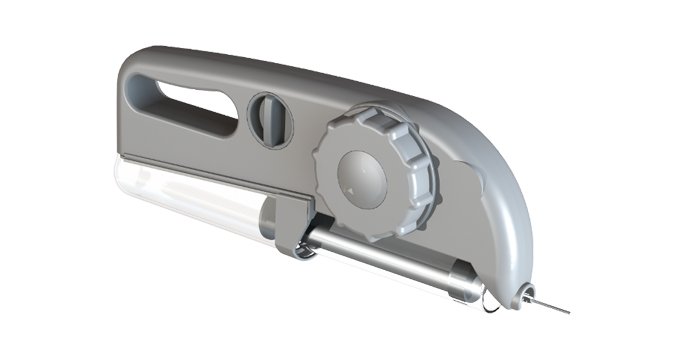
After the client had previously failed to design a working prototype for their medical product with a different vendor, they came to us to solve this problem and design it for manufacturability. The product is a syringe infusion system.
Product Website: Freedom60
Applicable Patents:
US11278669- Gear-driven infusion assemblies, systems, and methods
USD398053 - IV Pump
Summary: A prior vendor had created a design for the pump, but had been unable to demonstrate a working prototype (described below under “Failed Prior Design”). Convinced that the design would only function with production materials, prototype tools were constructed but the pump still did not work. Creative Engineering was approached by the client and asked to debug the design and get it working. We determined that the design was fundamentally flawed and offered to redesign it completely. We did so and the pump is now on the market. In redesigning the pump we were able to improve the performance, use less exotic resins in its manufacture, and introduce many aesthetic, ergonomic, and functional improvements to the product.
New Design Solution: Working with another mechanical designer, we came up with a solution that used a much weaker (but longer) constant force spring along with a pulley and cable system to provide the ratio needed to get the output up to 16 lb. In our improved design, a standard syringe is used. The cable is driven by a small diameter pulley, which multiplies the force of the constant force spring. We introduced many other improvements, such as a custom leur lock connector design keyed to the pump housing to ensure that only the proper IV set is used, and an innovative “tension sensing” swing gear that disengages the governor gear train (not shown) during a run in order to ensure smooth drug delivery. Winding the pump is simplified because the lighter spring allows the main pulley to be wound directly and we implemented a large easy-to-grasp knob rather than the winding handle of the previous design.
The earliest Proof Of Concept model was constructed and tested on a flow bench. This prototype demonstrated the validity of our design and gave our client the confidence to proceed to the next step, which was to design and prototype all of the other subsystems and consider the form factor and packaging issues. This prototype only incorporated the bare essentials- the knob to evaluate winding effort, the spring to store the energy, the small diameter drive pulley to multiply the force, the cable drive system to deliver the force, and a means to locate the syringe and push on the piston.
Given the success of the bench testing of the initial prototype, we had the confidence to invest the time to develop a fully functional design that accounts for the additional required functionality as well as developing a sleek form factor to package the components. A fully functional prototype was built based on the mechanical layout developed in Pro/ENGINEER and successfully demonstrated all of the functional aspects of the design. More refinement followed ultimately resulting in a complete CAD database ready for tooling, debugging, and production.
Other Vendor’s Failed Prior Design: A constant force spring was used to deliver about 16 lb. of force to a custom shortened plunger in an otherwise standard 60 cc syringe. In a fashion similar to other products on the market the fluid was then passed through very small diameter tubing in order to choke the flow to the desired rate. The constant force spring was concentrically wound with a metal tape very similar to that found in common tape measures.
The use of the metal tape resulted in a unit that was very compact, except for the fact that the entire syringe projected away from the housing. An escapement-type governor mechanism was used to prevent the unit from running too quickly under no-load conditions.
Problems: The main problem with that design was that the spring had to deliver the full 16 lbs of force at the outer diameter of the pulleys. Such a spring is quite thick and heavy, thus exerting such high forces that the housing was having trouble containing it and the winding mechanism would not function. Other issues:
The escapement governor was unreliable and very loud
The design required tight manufacturing tolerances and glass-filled resins
The syringe was very vulnerable to being knocked off the unit
A standard IV set could also work with the device (with dangerous consequences)
The winding torque was too high
The winding handle (much like a fishing rod) was awkward to use
Our work on this project helped our client secure the patent!
After this product was on the market for a while, we worked with the same client to come out with a new version of the product. Information on that project can be found here.



